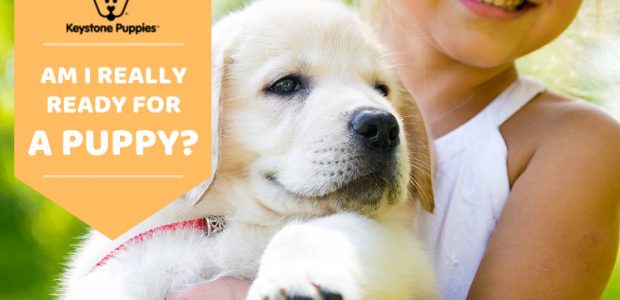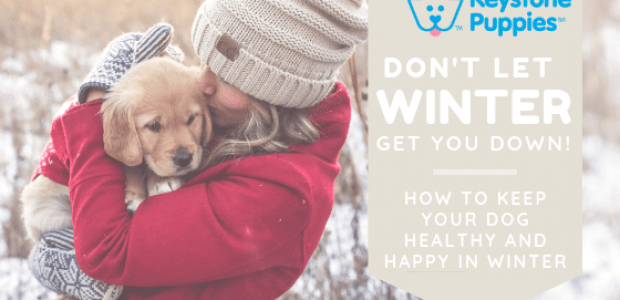Tips for Exercising Your Puppy in Winter Weather
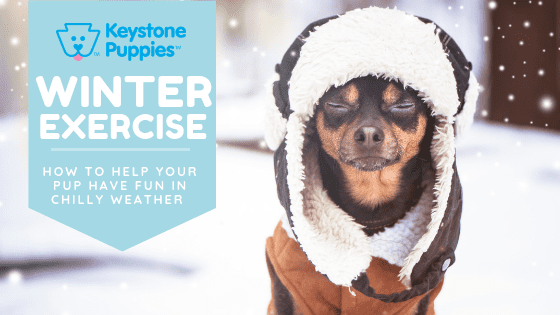
Winter is coming, and that means ice, snow, freezing rain, and bone-chilling winds. While humans have become quite adept at bundling up to protect against the cold, dog owners often assume their canine pal will naturally ward off the cold.
While some breeds, like the Siberian Husky or the Saint Bernard, were bred to live in snowy climates, most dogs have more trouble adjusting to the cold. (Check out our blog on Snow Breeds.) The first step to developing a successful winter exercise program for your dog is to figure out how well they can naturally deal with cold weather.
Evaluate Your Pup’s Weather Resistance
Dogs vary widely in their ability to feel cold and maintain a safe core body temperature. If your pup falls into of the categories below, you should invest in a winter coat for your pup, and consider purchasing booties with gripped soles. Check out coat-buying advice from the American Kennel Club.
Small, shorthaired breeds need protection in the winter. Small dogs don’t generate enough body heat to keep themselves warm. When you combine this trait with short hair that lets heat escape easily, your dog is at risk in cold weather. This category includes French Bulldogs and Boston Terriers.
Smaller breeds get cold faster than larger breeds. Even if your small breed dog has a thick coat, his small body is unable to retain body heat in the way that a large breed can. Keep an eye on these breeds in winter weather, especially if they are encountering ice or snow.
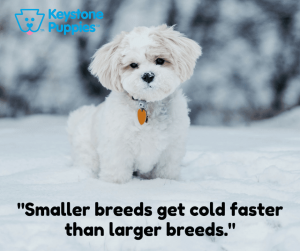
Dogs with bellies close to the ground also get cold faster since their bellies can pick up snow or ice.Welsh Corgi Pembrokes and Basset Hounds are included in this group.
Closely groomed breeds lose body heat quickly. Even the usually warm-blooded Standard Poodle can get chilly if you trim off the coat that protects them. Consider letting your dog’s coat grow longer in the winter to offer them more protection against the elements.
Even though they are often large dogs, lean, shorthaired breeds like Doberman Pinschers and Great Danes are not well-equipped to handle extended exposure to cold.
And finally, no matter what kind of dog you have, small puppies and senior dogs are more susceptible to cold. Consider using a pet coat and booties for your very young or very old dog when taking them into winter weather.
Fun Outdoor Exercise
Once you’ve evaluated your dog’s tolerance to cold, and protected him appropriately, it’s time to have fun outdoors! Here’s a list of outdoor activities you can do in almost any weather.
(1) Sledding or a Wagon
Pulling: Big dogs can pull a wagon or a sled with the use of a dog harness (available in many pet stores and online.) Many large snow dogs, such as Newfoundlands and Malamutes, were bred to pull sleds in the snow, so this may be deeply satisfying for them. If you invest a little time and training in getting them used to a harness and pulling on command, you may find that this becomes one of their favorite winter activities. Just make sure that the people or things they’re pulling are not too heavy for your dog’s size, strength, and fitness level.
Riding: For small dogs, especially those that dislike cold weather, consider bundling them up and slowly pulling them on a sled or wagon in the winter. The activity is mentally stimulating for them, and it allows them to enjoy chilly walks in comfort. As with pulling, getting your dog used to being pulled may take some training, but it can develop into a popular winter activity.
(2) Shoveling the Walk
If sledding is too advanced for your pup, keep your time in the snow simple. If your dog likes to dig in the snow, take him along when you go to shovel your driveway or walkway. He’ll enjoy “digging” alongside you. For leashed dogs, you can use a hands-free, waist-worn leash, and let your dog “work” alongside you.
(3) Fetch
If your dog likes to fetch, he’ll enjoy winter games of fetch as well. If you’re playing fetch in the snow, make sure you can keep track of your fetch item by sticking to items that are big and brightly colored.
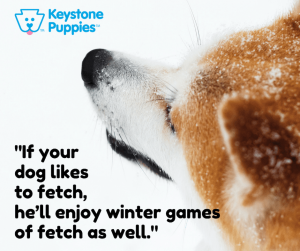
(4) Winter Walks
Whether you choose a short jaunt or a long hike, make sure you and your pup are bundled up appropriately. For winter walks, you may want to invest in an extendable leash, so your dog can dig and play in the snow along the way. If your pup is wearing a dog coat, make sure it’s open in the back so he can do his business easily. Stick to level terrain, especially if it’s icy or wet. And always bring a phone with you on your walks so you can call for help in case you or your dog slips in the cold weather. If your walking at dusk or in the dark, take extra precautions. Read more about walking your dog in the dark in this blog.
(5) Exercise Indoors
When all else fails, get creative with indoor play. There are a variety of activities you can do with your pup indoors including training exercises, working out with your pup, indoor soccer, and field trips to local dog-friendly locations. Find out more in this Keystone blog on indoor exercise.
Limit You Pup’s Time Outdoors
While a few snow breeds may enjoy extended time outdoors, for most breeds, you should monitor time outdoors. Factors like freezing weather, deep snow, high winds, or freezing rain make your dog’s temperature drop faster, so watch for signs of chilliness. If your dog is shivering, whining, sticking closely to you, trying to climb your leg, or shows other signs of anxiety, take your dog home immediately.
Keep Paws Clear of Ice and Chemicals
Dog paws can also suffer in cold weather. If you walk your dog on sidewalks, paths, or roads that are treated with salt or deicers, watch for limping. Icy paws can also cause your dog to limp. To remove the irritant, remove your gloves, and use your fingers to gently clean his paws, feeling for hard bits of salt or ice. You’ll also want to clean his paws when you return home with some warm water and a washcloth to remove any debris or chemicals. If bits of ice or deicer are a persistent problem, consider paw wax or dog booties. See our blog on paw care for more details.
Help Snow Dogs Keep Their Energy Up
While cool or cold weather will keep some dogs from having fun, many breeds thrive in cold weather. Dogs who enjoy the cold weather will seem energized, will hold their head up or prance. They may seem more playful or want to run or bound. For these winter-loving pups, it’s important that you watch their energy level. All this extra exercise may dehydrate or exhaust them. For these pups, you may want to bring a water bottle on your outings, and pack treats in your pocket to help them keep their energy levels high. And while it’s fun to watch them frolic, keep your dog’s usual energy levels in mind, and bring them inside when initial bursts of energy are spent.
***
Keystone Puppies wants you to give your puppy plenty of outdoor exercise, even in winter months. If you’re concerned about your pup’s ability to withstand cold, talk to your vet about the best approach to winter exercise. If you’re not sure which dog is right for you, research over 200 breeds by clicking here. If you already know what kind of puppy you want, start your search for your dream dog here.





